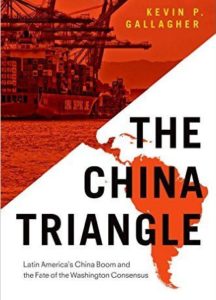During its twenty-first century rise to a world economic power, the fastest and strongest economic growth ever recorded, China, the “Dragon”, has increasingly purchased and invested in Latin American commodities. This led to the “China Boom”, a ten-year period (2003-2013) in which Latin America’s economy increased 3.6% each year. However, Latin America failed to capitalize on this growth by not investing their unexpected fortune, or windfall, and they became too dependent on exporting their natural resources and goods, causing a financial crisis. Although at first he was neither disposed to the idea nor prone to the subject, economist, professor, and author Kevin Gallagher discovered that the China-South America relationship was an important one. From Boston University, where he conducted much of his work, Gallagher argues that reform is still possible for Latin America because China is still investing, and so there are still windfalls that should be invested.
 In The China Triangle: Latin America’s China Boom and the Fate of the Washington Consensus, Gallagher argues that a new age of trade between Latin America, China, and the United States, forming the “China Triangle”, is now here. Though the book is far from an easy read and the text is occasionally redundant or dry, Gallagher pulls from the research and knowledge of a vast range of economic experts and public policy commentators to support his points. Although Latin America must continue to draw on China and the United States, the two biggest economies in the world, Gallagher emphasizes that Latin Americans alone is responsible for their economy, and that with reformed taxation, special funds, and modified policy and strategy they can begin to reap the appropriate benefits from their rich “natural capital”.
In The China Triangle: Latin America’s China Boom and the Fate of the Washington Consensus, Gallagher argues that a new age of trade between Latin America, China, and the United States, forming the “China Triangle”, is now here. Though the book is far from an easy read and the text is occasionally redundant or dry, Gallagher pulls from the research and knowledge of a vast range of economic experts and public policy commentators to support his points. Although Latin America must continue to draw on China and the United States, the two biggest economies in the world, Gallagher emphasizes that Latin Americans alone is responsible for their economy, and that with reformed taxation, special funds, and modified policy and strategy they can begin to reap the appropriate benefits from their rich “natural capital”.
In his first of eight chapters, “The China Triangle”, Gallagher outlines the Washington Consensus, ten economic reform policies instituted through the IMF and World Bank aimed at restructuring developing countries. Though both countries were optimistic, the success of the Washington Consensus was minimal, according to Gallagher. The treaties, he says, left countries without the necessary freedom to invest in exportation and innovation. Eventually Latin America withdrew, believing they had a better alternative: China. Originating from Chinese purchases of natural commodities such as copper from Peru and Chile, steel from Brazil, beef from Argentina, and fuel from Venezuela, Mexico, and Ecuador, the China Boom surpassed the Washington Consensus politically and economically.
Gallagher discusses the different globalization strategies employed by the United States and China, the two world powers. During the rapid rise of the West at the end of the nineteenth century, Latin America supplied the majority of the necessary natural resources. Unlike after the recent China Boom, Latin America wisely invested their windfall in infrastructure, such as railroad construction. Following that was a state-led industrialization period where domestic capitalist markets increased industry wages and discouraged the lucrative international trade, temporarily embodying a protectionist stance. The United States supported these actions. Despite the struggles of the 1980s, Latin America enjoyed the highest GDP growth during this period, which ended at the implementation of the Washington Consensus when the White House provided financial support to Latin America on the condition that each country establish several reforms aimed at reducing the role of the state in economic affairs. Gallagher emphasizes the failures of these treaties and China’s alternative solution. China initiated its own “boom” by gradually transitioning into the private sector and investing in infrastructure at a time when Latin America was obstructed from doing so by Western foreign regulation (39). From 1990-2010 alone, China’s economy went from one half to double the GDP of Latin America.
An industrialized, financed Latin America “won the China lottery” by providing the natural resources the booming nation needed, according to Gallagher. In 2013, their exports to China were seven times the exports to the rest of the world combined (44). Although iron ore, soy, copper, and petroleum were the largest exports in quantity, respectively, Latin America imported a shockingly large number of Chinese goods, a figure that increased by a factor of 20 since 2000 while all other imports merely doubled. By investing abroad in primarily the energy and mining sectors, “China is supporting the globalization of its national champion companies like none other before” (51). ICBC, one of China’s top national banks, even took an 80% stake in the Standard Bank of Argentina for $700 million in 2011 (58). Gallagher cites the World Bank’s thought on Latin America’s economic growth as “an important measure of its connections to China” (62).
Similar to President Taft’s “Dollar Diplomacy” in the early 1900s, Gallagher illustrates an economic foreign policy strategy utilized by China called “Yuan Diplomacy”. Chinese diplomats have made frequent trips to Latin America over the past decade in order to leave billions of dollars in financing. Citing his popular research on the subject, Gallagher claims his findings show that Chinese lending in Latina America exceeds that of IDB Bank and the World Bank, two large commercial banks with vast international networks. Gallagher states China is using this strategy because Latin America contains the key commodities China needs at its current stage of development, and the continent serves as a viable option for many Chinese companies looking to globalize in similar commodities (73). The latter part of “Yuan Diplomacy”, the fourth chapter, explores the debates over Chinese foreign financing. Some view it as “neocolonial” and exploitive, and others as far too generous and impossible to counteract. Due to his findings over the past five years Gallagher concludes that “the majority of Chinese finance in Latin America is offered at commercial rates of interest”, so in other words, Chinese financings is fair and competitive (78).
Gallagher devotes a chapter to the concept of the “resource curse”, a tendency for countries with rich supplies of natural resources to perform worse than those countries without such endowments due to the absence of strong institutions and the ability to capture and invest wealth. The cure, according to Gallagher, is for the government to tax the export sectors during moments of windfall and then invest an average of 25% of that income (93). Despite the largest influx of windfall in their history, Latin America has thus far failed to do this. To make matters worse, Gallagher’s research shows that 78% of Latin American manufacturers are losing to China (97), and their debt, which is mostly denominated in dollars, is rapidly increasing as national currencies depreciate, relative to the dollar. Although there is much reform and work to do, “[Latin America] should be praised for spending what little increases they did capture on combating poverty and inequality, enabling the region to reverse the uptick in inequality that occurred during the Washington Consensus period” (146).
Before he moves on to the central question of saving the China Boom and navigating the China Triangle, Gallagher does not ignore what he calls the “Dragon’s Footprint”. Relative to other Latin American commerce, their trade with China is by far the most environmentally destructive (124), and the onus is on both parties to manage the issue. Latin American governments must manage their resources wisely and properly. China will need to improve its environmental footprint by upgrading, implementing, and enforcing more considerate policies, or surely risk further opportunities for globalization in other countries and sectors. “When given the proper incentives by governments or civil society, Chinese companies are capable of adapting to domestic laws and global norms” (132). Gallagher outlines the specific mistakes China has made and probable improvements and reform efforts they are taking to reduce the detrimental impact of their industrialization and trade in Latin America.
In his detailed and informative outline of how to best save the China Boom and navigate the China Triangle, Gallagher supports liberal economic policy and critiques Republican legislation that would seek to avoid handouts to struggling governments in the pursuit of future equity and investment in the South American region. Despite his political stance influencing his writing, Gallagher makes his opinions and their supporting evidence clear. For the best chances of success with this new trade triangle, Gallagher insists that the United States approach and deal with Latin America as an equal and not a proctor, as he claims they did in the past. This trade can be beneficial for all parties, if utilized correctly. “Now is a perfect time for the United States to hit the reset button on foreign economic policy in Latin America—and for Latin America to do the same toward the United States.” (176-177). Gallagher claims that during the China Boom, both parties took each other for granted, and since then, US-Latin American trade has not been what it should be.
Gallagher advocates a middle ground approach between the state-led industrialization of Beijing and the United States’ ideology of the Washington Consensus as a way to utilize trade and reap benefits from the China Boom. He closes by asserting that China-Latin American trade will not end anytime soon. US-Latin American trade is still equal to (and larger in many sectors) than Chinese trade, and that relationship should stay alive as well. In the end, “the onus is on Latin America” to fully reap the benefits of the China Triangle and what is left of the China Boom.
The China Triangle is an informative and comprehensive study for the avid student or economist seeking information and analysis. Though he neglects very little regarding the history, trends, and facts of the economic ties between China, the United States, and Latin America, Gallagher forfeits brevity and personal story or insight in his text for the sake of academic thoroughness and professional evaluation. Nevertheless, his argument is organized, meticulously supported, and leaves the reader with a clear understanding of the nature and future implications of “The China Triangle”.
—
Ryan McDowell is an intern for Providence. He is studying Business Administration and Economics at Pepperdine University and has studied in Argentina.
Photo Credit: Mexican President Enrique Peña Nieto and Chinese President Xi Jinping delivering a joint statement to the media in Mexico City on June 4, 2013. By Presidencia de la República Mexicana, via Flickr.







 Sponsor a student for Christianity & National Security 2024
Sponsor a student for Christianity & National Security 2024